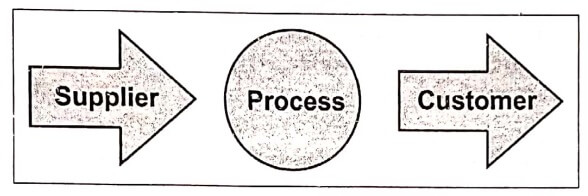About Juran
Juran’s contributions – Juran born in Romania (1904) and emigrated to America in 1912.
- 1951 – published “Quality Control Handbook”.
- Mid 1950’s – like Deming, travelled to Japan to conduct top and middle level executive seminars on planning, organisational issues, management responsibilities for quality and the need to set and monitor improvement target goals.
✓ Juran has authored hundreds of papers and 12 books, including “Juran’s Quality Control Handbook”, “Quality Planning and Analysis”, and “Juran on Leadership iur Quality”.
✓ Juran has been awarded over 30 medals and fellowships world wide, including Japan’s highest honour for a non-Japaneses citizen, the Second Order of the Sacred Treasure presented by the Emperor.
Juran’s Contributions
Juran’s contributions can be studied under the following five topics:
|
1. Internal Customer
Juran realised that the customer was not just the end customer and that each person along the chain has an internal customer. Each person along the chain, from product designer to final user, is a supplier and a customer.
In addition, the person will be a process, carrying out some transformation or activity. Therefore Juran maintained that at each stage was a “three role model”: supplier, process, and customer, as shown in Fig.1.

Fig. 1. Juran’s “three role model”
2. Cost of Quality
Juran classified the cost of quality into three classes as:
(i) Failure costs: Scrap, rework, corrective actions, warranty claims, customer complaints, and loss of customer.
(ii) Appraisal costs: Inspection, compliance auditing and investigations.
(iii) Prevention costs: Training, preventive auditing, and process improvement implementation.
Juran demonstrated the potential for increased profits that would result if the costs of poor quality could be reduced.
3. Juran’s Quality Trilogy
✓ Juran views quality as fitness-for-use. He also believes that roughly 80% of quality defects are management controllable. Thus management has the responsibility to correct this deficiency.
✓ Juran divides quality management into three parts. They are given below:
|
1.Quality planning: Objectives are to determine quality goals; to form implementation planning; to do resource planning; to express goals in quality terms; and to create the quality plan.
|
|
2. Quality control: Objectives are to monitor, performance; to compare objectives with achievements; and to act to reduce the gap.
|
|
3. Quality improvement: Objectives are to reduce waste; to enhance logistics; to improve employee morale; to improve profitability; and to satisfy customers.
|
✓ According to Juran, quality planning is necessary to establish processes that are capable of meeting quality standards; that quality control is necessary in order to know when corrective action is needed; and that quality improvement will help to find better ways of doing things.
✓ The entire concepts of Juran’s quality trilogy can be summarised as shown in Table 1.
Table 1.Juran’s quality trilogy
|
1.Quality Planning
|
|
2.Quality Control
|
|
3. Quality Improvement
|
4. Juran’s 10 Steps for Quality Improvement
Juran proposed 10 steps for quality improvement. These are shown in Table 1.2.
Table 1.2. Juran’s ten steps to quality improvement
|
1.Build awareness of the need and opportunity for improvement.
|
|
2. Set goals for improvement.
|
|
3. Organise to reach the goals.
|
|
4. Provide training.
|
|
5. Carry out projects to solve problems.
|
|
6. Report progress.
|
|
7. Give recognition.
|
|
8. Communicate results.
|
|
9. Keep score.
|
|
10. Maintain momentum by making annual improvement part of the regular systems and processes of the company.
|
5. The Breakthrough Concept
Like the Deming cycle, Juran’s breakthrough concerns itself with the product/service life cycle. In essence, this splits it up into two areas: the “journey from symptom to cause” and the “journey from cause to remedy”.
| Read More Topics |
| Hot working and cold working metal forming |
| High pressure boilers modern |
| Optical comparator working principle |






